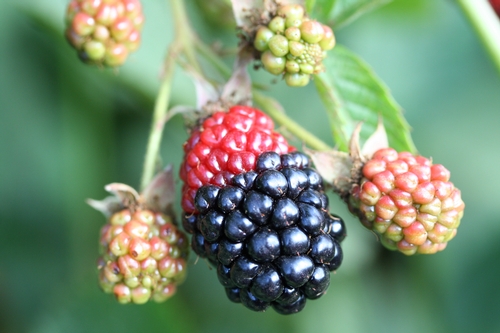Utility of Fall Applied Lime Sulfur in Reducing Incidence of Redberry Mite in Blackberry
As readers of this space already know, the utility of fall applied lime sulfur for controlling redberry mites in blackberries has been questioned. Previous collaborative work has shown that 3-4 applications of Golden Pest Spray oil at a dilution of 1.2 – 2% volume to volume applied at the 50% green fruit stage in the spring is the most effective way to control this pest in blackberry.
This past year, the authors partnered to test the thesis that fall applied lime sulfur, with and without flowable sulfur, would not have an effect on total redberry mite infestation later on in the season. The trial consisted of each treatment (no winter application, 15 gal/A lime sulfur applied twice, and 15 gal/A lime sulfur + 10 lb/A flowable sulfur applied twice) being replicated four times. In turn, each treatment replicate plot was composed of three side by side 250 foot long tunnels, with each tunnel covering three rows of blackberries (meaning each treatment replicate had nine rows of blackberries).
First application of 15 gal of lime sulfur and 15 gal of lime sulfur + 10 lbs wettable sulfur was made November 18, 2013 and the second application of the same was made January 17, 2014. In the spring, two applications each were made of of wettable sulfur (12 lbs per acre) and Golden Pest Spray oil (1.5% to 2%). All other crop and pest management procedures were made as necessary to the maintenance of the crop.
Starting June 29 and continuing weekly through the end of July for a total of six evaluations, total number of marketable fruit and redberry mite fruit were counted in a four foot long section of each three tunnel replicate plot. Statistical evaluation was done as a percentage redberry mite infested fruit compared to total amount of fruit.
As the reader can see from the data presentation below, lime sulfur used either alone or lime sulfur applied with sulfur had no effect on redberry mite incidence in the field in this study. While it is to be noted that this is a single trial run in a drought year, it nevertheless adds a good data set to the consideration of the question of the utility of fall sulfur applications for redberry mite.
|
Evaluation date |
%RBM affected fruit 6-29-2014 |
%RBM affected fruit 7-3-2014 |
%RBM affected fruit 7-10-2014 |
%RBM affected fruit 7-17-2014 |
%RBM affected fruit 7-24-2014 |
%RBM affected fruit 7-31-2014 |
|
No Winter Treatment |
2.66 |
2.66 |
3.32 |
5.01 |
12.50 |
11.99 |
|
15 gal/acre lime sulfur |
1.70 |
2.81 |
3.25 |
7.23 |
9.44 |
16.93 |
|
15 gal/acre lime sulfur + 10 lb/acre flowable sulfur |
1.94 |
3.20 |
3.73 |
7.69 |
11.82 |
13.06 |
None of the means of the percentages of redberry mite infested fruit differ significantly at the 5% level.

Redberry mite affected blackberry fruit. Note clear demarcation between affected, unripe druplets and those which are not.
Comments:
So, much like you, my private industry colleague and I found that the program of oils applied over a two month period after flowering does the trick. The multiple applications I think make up for the uncertainty in timing.
If you have a moment and are willing to share, what exactly drives the timing of your sulphur applications?
We are in the middle of harvest at present so pretty busy but we should be finished the boysenberries and early blackberries in a couple of weeks. I usually analyse all the berry growers spray diaries during February so can work out an average sulphur timing and am happy to share the results. We also use an East Malling model which works on GDD for control of Blackcurrant Gall mite for which sulphur is the main control which might be a pointer for Redberry mite timing as they are similar mites. I will e-mail you the details


Redberry mite is an issue we have had for many years in New Zealand. Our main control approach used to be Endosulfan but we have found one or two well timed spring sulphur applications at 10kg/ha has maintained a level of control such that we don't see the mite at levels where it is a problem
Posted by Geoff Langford on December 14, 2014 at 1:42 PM